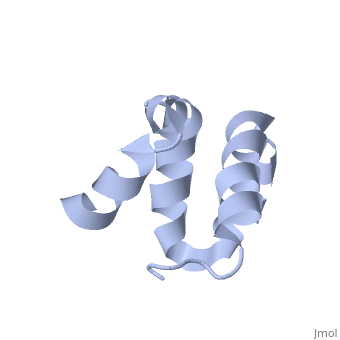2lnm
From Proteopedia
Solution structure of the C-terminal NP-repeat domain of Tic40, a co-chaperone during protein import into chloroplasts
Structural highlights
FunctionTIC40_ARATH Involved in protein precursor import into chloroplasts. Part of the motor complex consisting of a co-chaperone (TIC40) and a chaperone (HSP93) associated with the import channel (TIC110). Causes the release of bound transit peptides from TIC110 and stimulates ATP hydrolysis by HSP93. Involved in reinsertion of proteins from the chloroplast stroma into the inner membrane.[1] [2] [3] [4] [5] [6] Publication Abstract from PubMedChloroplasts protein precursors translated in the cytosol traverse the membranes to reach their intended destination with the help of translocon complexes called translocon at the outer envelope of chloroplasts and translocon at the inner envelope of chloroplasts (TIC), respectively. Two components of the TIC translocon, Tic110 and Tic40, which combine with Hsp93 (ClpC), are involved in protein translocation across the inner membrane into the stroma. The C-terminal NP-repeat domain of Tic40 (Tic40-NP) is homologous to the DP-repeat domain of co-chaperones Hsp70-interacting and Hsp70/Hsp90-organizing proteins. Interaction of Tic40-NP and Hsp93 stimulates ATP hydrolysis of Hsp93, but the hydrolysis is abolished in both N320A and N329A mutants of Tic40-NP. Here, we determined the nuclear magnetic resonance structure of Tic40-NP, which mainly consists of five alpha-helices stabilized by two hydrophobic cores. In addition, chemical shift perturbation results suggested that some residues at alpha1 and alpha5, as well as residues Asn320 and Asn329, cause conformational change on the two mutants, which may subsequently affect their binding to Hsp93. We provide valuable information for further investigating how Tic40-NP interacts with Hsp93. Solution structure of the C-terminal NP-repeat domain of Tic40, a co-chaperone during protein import into chloroplasts.,Kao YF, Lou YC, Yeh YH, Hsiao CD, Chen C J Biochem. 2012 Nov;152(5):443-51. doi: 10.1093/jb/mvs086. Epub 2012 Aug 10. PMID:22888115[7] From MEDLINE®/PubMed®, a database of the U.S. National Library of Medicine. See AlsoReferences
| ||||||||||||||||||

